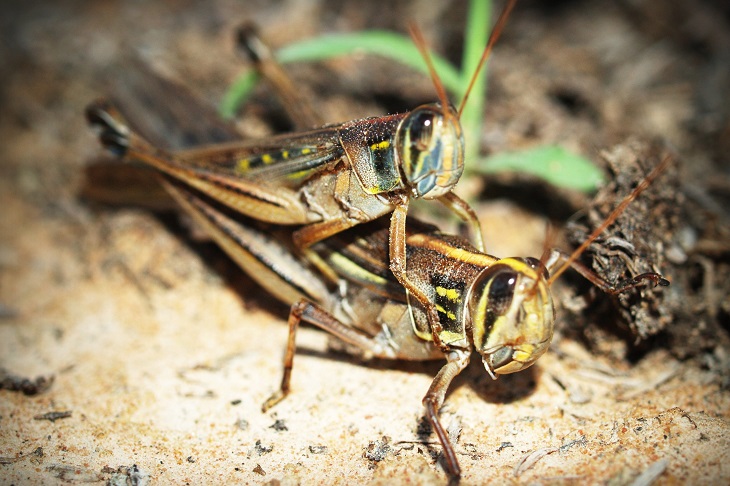Clicking on the link to a recent Reader’s Digest story about common foods that secretly contain insects was a mistake.
I could have lived my whole life without knowing 125 grams of chocolate probably contains ‘74 insect fragments’ – whatever those are. No wait… They elaborate. Cockroaches are the most common donor of these ‘body bits’ that fall into the machines during harvesting where they get ripped up and roasted. The FDA considers this to be an ‘insignificant’ level of cockroach garnish. I’m … setting aside my chocolate Easter eggs for a few hours while I decide.
More bad news, the average cup of coffee comes with 120 insect parts – so that’s me back to tea (which I refuse to Google, and don’t you dare do it on my behalf, or leave any details in the comment section). Pasta packs a bit of extra protein at 225 insect bits per 225 grams, which is mostly coming out of the wheat with 75 insects in a quarter cup. If you were going to whip up a quick Italian sauce, keep in mind that the canned tomatoes come with 8 fly eggs.
While I can probably get beyond the powdered cockroach legs, the fruit-fly eggs inside dried raisins are a little more disturbing, as is the revelation that fresh mushrooms contain 19 maggots and 74 mites per 100 grams. No thanks. I don’t care that these provide ‘more protein than chicken or salmon’.
Human beings are not insectivores.
Some of our distant ancestors picked off the odd bug and a few of our jungle relatives have adapted to hunt down multi-legged things with wings. Humans do not have the correct enzymes to properly breakdown the exoskeletons of bugs on a regular basis. We have specifically evolved to eat meat, vegetables, fish, and fruit – not grass and bugs – which is why we instinctively turn our noses up at insects.
Yes, if manufacturers turn a few accidental trespassers into a powder, we might not notice a meal of insect parts – and certainly there are isolated populations capable of frying up a tarantula, a handful of dragonflies, and giant water bugs during a communist leap. People will eat almost anything in a famine – including their own children.
None of this means we want to see mass-produced cricket milk on the supermarket shelf. If the peak of this ‘new normal’, progressive, Net Zero era means we’ve been reduced to preying on the cockroaches crawling over the rubbish then something has gone critically wrong with Western Civilisation.
Enter the European Union.
The dystopian bureaucracy, which gets upset if foreigners appropriate French names for their champagne, has ruled that mealworm larvae (which looks like maggots) along with crickets have been added to the list of insects that are allowed to be sold as food within the European Union. There are eight more tasty insects awaiting review.
They can be distributed as ‘powder, frozen, paste from dried worms’ and the crickets as ‘defatted powder’.
This might be okay if insect products were treated like faux meat tucked away at the end of the aisle behind the Tofurkey. Instead, the approval means that food companies can use insects as cheap additives to bulk out profit margins and sell food laced with bugs hidden beneath indecipherable ingredient descriptions. Heaven forbid regulators did something sensible, such as putting a big sticker of a spider on the side of the packaging.
We should not kid ourselves. Bugs are being served up because they can be grown in labs, ensuring guaranteed agricultural sales for BioTech and chemical companies. It’s a highly unappealing farming industry that has almost no connection to the natural world. Knowing that very few people would willingly trade free-range steak for a bug raised in a plastic crate by robots, the industry has wrapped itself in climate alarmist marketing campaigns.
‘Most of the planet-heating pollution from food, which accounts for about one-quarter of global warming, comes from meat and dairy. Cows and sheep belch methane, a strong but short-lived greenhouse gas, and farmers raze forests to make pastures and grow soy, three-quarters of which is fed to livestock. If fried crickets and mealworm salads replace some steaks and hamburgers, they can play a small role in stopping species from dying out and the curbing of climate change.’
Let’s put that inside a tiny bit of rational perspective. This ‘planet saving’ philosophy wants to kill off animals grazing on fields of grass – something land animals have always done which supports an entire ecosystem – and replace them with sprawling glass, concrete, and steel labs filled with chemicals and equipment. This production is over 90 per cent reliant on fossil fuels – particularly petroleum – and creates a lab environment to nurture and raise billions of insects that have a reasonable chance of making people sick from eating them.
‘Disgust is seen as the biggest hurdle for the introduction of insects to the Western food market,’ said one study. While another said that people were more likely to eat insects if they thought they were saving the planet.
Others have suggested feeding the insects to livestock like chickens.
If only nature had thought of that. Wait…
The real problem with the European Union is that it will now be legal to slip insect powder into pasta, flour, bread, biscuits, soups, and sauces.
Expensive brands will pride themselves on their bug-free purity. It will be the poor who wind up eating insects, not the wealthy Net Zero priests at Davos.
The solution is obvious for most of us – go full carnivore. But what are the vegans going to do?
For those who cannot eat honey in case it hurts the bees’ feelings, how are they going to cope with the knowledge that their food contains hundreds of bug parts? And what are they going to do when bug flour becomes the norm?
While vegans proudly say that ‘no, they do not eat bugs’ – evidently they do, by the truckload, even if only by accident. If they want to save the planet, they better ditch their sympathy for beady eyes and accept that Net Zero is more important.
As for me, the only bugs I intend to eat are Moreton Bay Bugs.

























